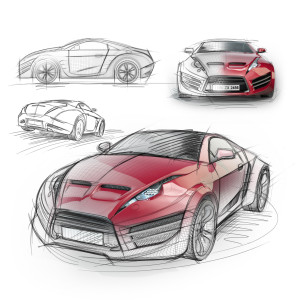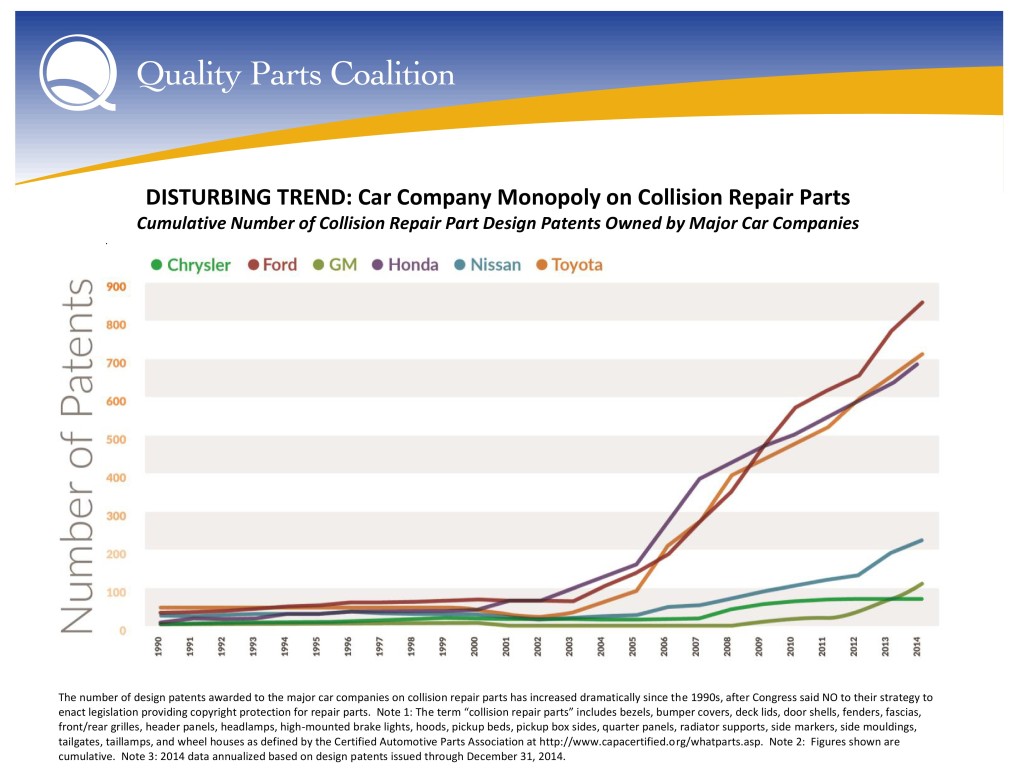
Claiming abuse of system, QPC, PARTS Act seek to cut design patent life for auto OEM parts — but no one else’s
By onBusiness Practices | Insurance | Legal | Market Trends | Technology
Claiming that automakers are overpatenting vehicle part designs to drive out cheaper copies and keep prices high, the Quality Parts Coalition has launched a campaign in support of the PARTS Act, which would allow aftermarket copies of individual components sooner.
QPC Executive Director Ed Salamy said the OEMs are also abusing the patent system by patenting the overall look of a car but the individual design elements as well.
“They’re essentially double-dipping,” he said.
PARTS Act bills were introduced in February by U.S. Sens Orrin Hatch, R-Utah; Sheldon Whitehouse, D-R.I.; U.S. Reps Darrell Issa, R-Calif.; and Zoe Lofgren, D-Calif. The QPC kicked off its publicity push in support Tuesday.
Under the bill, original automotive OEMs — and no one else — would lose design patent protections after 30 months. Right now, any design patents issued by the government are good for 14-15 years.
Design patents are different from what one would consider a traditional “invention” patent (known as a “utility” patent). They’re purely aesthetic — there’s no function at all. It’s the difference between patenting a funky triangle-heavy grille (design) and patenting one meant to protect a pedestrian (utility).
The number of design patents issued to Ford, Toyota and Honda started to skyrocket around 2000-03, with Nissan starting to do the same but on a smaller scale around 2005. There are indications GM started on an upward trajectory too around 2011 (remember, it had other things on its mind during the recession), based on the QPC’s data.
And the OEMs have become “real agressive” about using them to combat aftermarket copies, according to Salamy.
“That’s not something they had done before,” he said.
Salamy couldn’t point to a reason for the change in policy.
“I wish I knew the answer to that specifically,” he said, but estimated the tactic originated with Ford in 2005.
We’d guess this started to coincide with last decade’s increased aftermarket parts demand from insurers looking to drive margins. (Trial lawyers and a slew of natural disasters probably did push up losses, but some of the blame for higher combined ratios has got to fall on the insurance ad war spending.)
Aftermarket manufacturers start copying more parts, and OEMs start patenting more designs to fight back. (One also sees the rise of “conquest” parts during this time to compete.)
Aftermarket parts haven’t been really dwindling as a proportion of repair bills or total parts installed, based on Mitchell data. But Salamy attributed that OEMs haven’t been enforcing the patents (which haven’t been in play that long) until recently.
“You’ll start to see those (aftermarket) numbers go back,” he said.
We contacted the U.S. Patent Trademark Office about the about the QPC’s “double-dipping” complaint but were told it doesn’t comment on pending legislation. A spokesman referred us to this guide for a question about the design patent process’ rigor.
Also asked about “double-dipping,” Dan Gage, director of communications and public affairs for the Alliance of Automotive Manufacturers, argued for the merit of design patents.
“A BMW is a BMW because it looks like a BMW,” he said in describing the overall design of a car. “A Ford F-150 is the same way.”
But individual components had their own aesthetics as well, he said.
OEMs do have to go through the same design patent vetting described in the PTO guide as everyone else. (For example, manufacturers of planes, bicycles, boats, etc.)
However, the PARTS Act merely singles out automotive OEMs. No other manufacturers would be affected — including aftermarket companies. So a parts manufacturer or SEMA modder shop can patent the look of a tricked-out substitute grille for more than a decade, but an automaker gets less than three years of protection on a new style of OEM grille. Salamy said it wasn’t necessary for non-OEMs.
The OEMs indicated to lawmakers they’re actually OK with aftermarket manufacturers who don’t copy a part outright.
“The underlying premise for the PARTS Act is that competition requires copying,” the alliance and other opponents wrote to senators in February. “This premise is false. Many aftermarket companies are successful in producing interchangeable parts that do not copy the exterior appearance of the OEM component. In fact, the U.S. aftermarket is replete with headlights, taillights, grilles, and bumpers that do not copy OEM designs but are interchangeable with the original components. This type of activity by aftermarket companies is a form of fair competition that respects and comports with existing patent protections. These companies employ designers that create original designs, provide consumers with greater repair choices, encourage innovation and protect the public from mistakenly buying a generic part when they intended to purchase an OEM replacement. Seen in this light, the PARTS Act is a solution in search of a problem.”
Safety
Things get muddied a little when you take safety into consideration — another argument raised by the OEMs. This goes back to the nature of design patents versus utility ones, something that even the PTO admits can be a tricky distinction:
Both design and utility patents may be obtained on an article if invention resides both in its utility and ornamental appearance. While utility and design patents afford legally separate protection, the utility and ornamentality of an article are not easily separable. Articles of manufacture may possess both functional and ornamental characteristics. …
A design for an article of manufacture that is dictated primarily by the function of the article lacks ornamentality and is not proper statutory subject matter under 35 U.S.C. 171. Specifically, if at the time the design was created, there was no unique or distinctive shape or appearance to the article not dictated by the function that it performs, the design lacks ornamentality and is not proper subject matter.
So for automakers to claim that infringing on a patent on the appearance of an object compromises its function is sort of wrong from a federal patent sense, even if accurate from a practical sense. Their stance in favor of aftermarket parts which look different, meanwhile, sounds correct from a federal patent perspective, but damages their imitation-parts-aren’t-as-safe argument.
But on a practical sense, their argument and the QPC rebuttal are worth careful consideration by consumers and lawmakers.
“Manufacturers of unlicensed automobile parts have to meet only one basic threshold: to produce a copy that can be passed off as an original part,” the alliance wrote. “… Automobile companies must ensure that all automotive components perform as a cohesive system during crash testing to provide the safest possible product for their customers. Accordingly, the manufacturer of the original product for whom such unlicensed replacement parts are made does not know how these parts will perform with the rest of the vehicle or how their use will impact the quality and integrity of the original product. Automotive collision repairers are also very concerned about the quality of replacement crash parts. Permitting infringement of this intellectual property also exposes consumers to significant safety, performance and durability risks without their knowledge.”
The debut of sensors, cameras and more advanced materials — not to mention seemingly cosmetic parts designed with a safety issue in mind (such as our grille example above) — in cars means that slight differences in aftermarket parts — even those which replicate the new technology — theoretically have a greater potential of throwing off a broader system.
Calibration experts noted at SEMA that tiny changes to a showroom-floor, all-OEM car — even aftermarket tires — could throw off sensors and require recalibration. OEMs and collision repairers have argued with aftermarket manufacturers about how well aftermarket bumper beams and other components protect occupants or affect airbag timing.
“A tenth of an inch is an awful lot,” Gage said of performance differences between OEM and non-OEM parts.
Non-OEM parts technically don’t have to notify the feds about recall inquiries, and Takata was a rare example of the NHTSA going after someone other than an automaker with a recall, the National Highway and Traffic Safety Administration told us earlier this year.
The QPC tells customers that aftermarket parts are safe, writing, “The quality is assured by manufacturers and distributors who provide warranties on their parts. QPC members often have warranties that exceed those offered by the car companies. Many quality alternative parts are certified by an independent third party.”
But warranties for fit and corrosion don’t guarantee safety, and the aftermarket manufacturers don’t have the kind of reputations to protect that OEMs if the part fails. (Is an imitation parts manufacturer really going to command headlines and congressional hearings if their part fails the way a General Motors component malfunction would?)
Plus, the law doesn’t allow only certified aftermarket parts — which according to the NSF and CAPA still don’t undergo all the IIHS crash tests of an OEM part — to copy OEM parts after 30 months. It lets any part manufacturer, regardless of certification, do that. And there’s a lot of junk out there, as CAPA itself will tell you.
The QPC does cite the IIHS’ 2010 conclusion that cosmetic aftermarket parts “serve no safety or structural function,” which drew upon research from a decade earlier. But 2000 is eons ago in car technology years, and perhaps it’s time to reconsider it and what impact aftermarket cosmetic parts have on the new sensor technologies and overall weight of the vehicle.
The IIHS also warned in the same article that aftermarket bumper beams aren’t cosmetic, and non-CAPA aftermarket ones weren’t performing as well as CAPA ones. It urged consumers to be wary of non-CAPA aftermarket beams.
Even then, we’d wonder how well the CAPA bumper standard held up if the IIHS were to crash-test every vehicle, not just one or two 2008 Dodge Ram 1500s. We know how well OEM bumpers and bumper covers do or don’t work; we can see the IIHS findings.
It’d also be interesting to see how certified and uncertified aftermarket parts fare under the new 2012 IIHS narrow-offset crash test. OEMs are having difficulty passing that one, as this video from the IIHS demonstrates:
More information:
“Quality Parts Coalition Frequently Asked Questions”
Quality Parts Coalition, Dec. 1, 2015
Quality Parts Coalition via PRNewsweb, Dec. 1, 2015
Alliance of Automotive Manufacturers, March 23, 2015
“Aftermarket bumpers meeting new standard perform well in crashes”
IIHS Status Report, Nov. 3, 2010
Images:
Quality Parts Coalition Executive Director Ed Salamy said the OEMs are abusing the patent system by patenting the overall look of a car and the individual design elements as well. (-M-I-S-H-A-/iStock/Thinkstock)
This chart shows the number of design patents granted OEMs in recent years. (Provided by Quality Parts Coalition)

